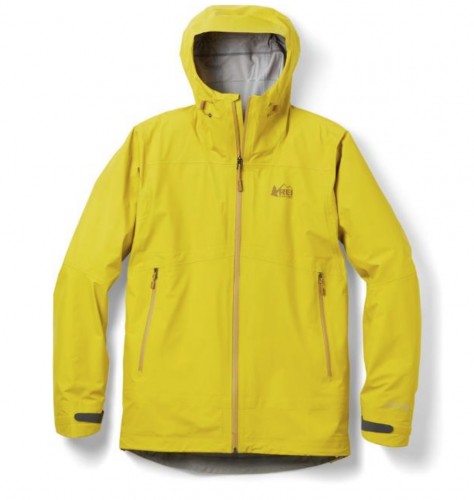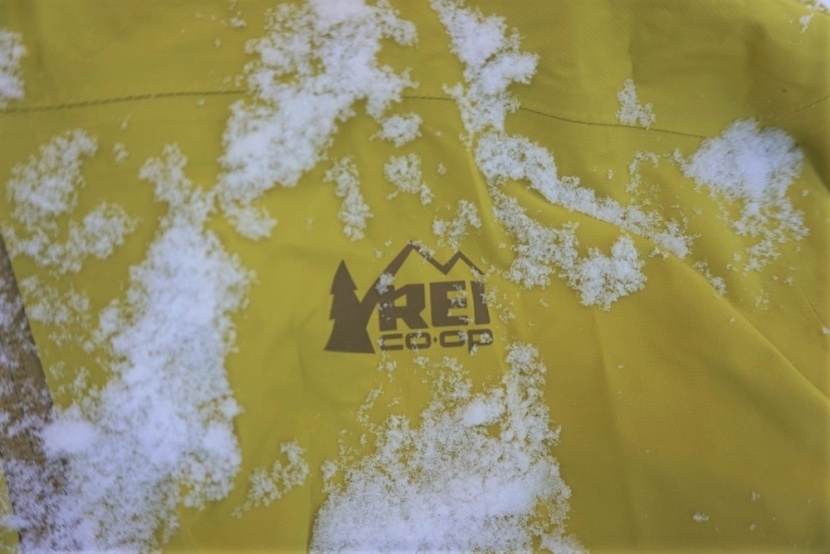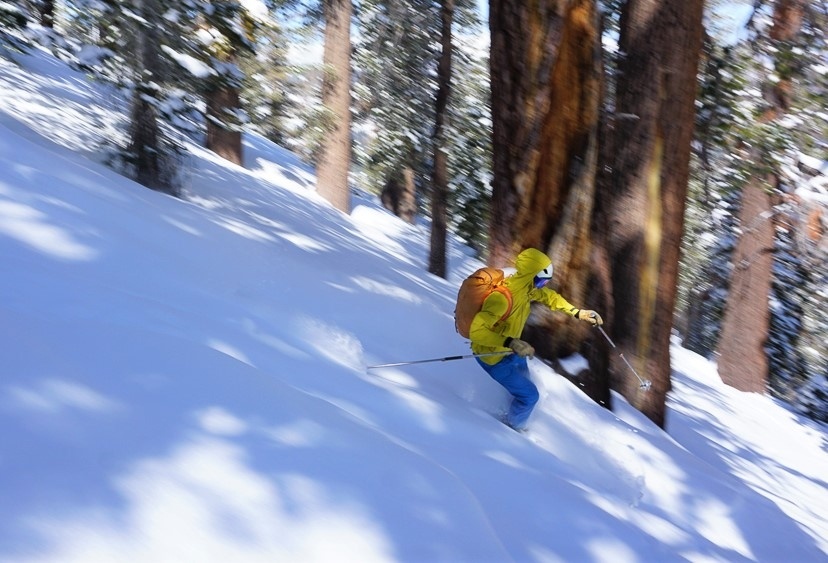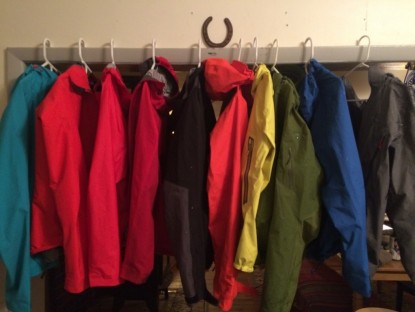REI Co-op Drypoint GTX Review
Our Verdict
Our Analysis and Test Results
If you're in the market for an affordable hardshell, anything made with Gore-Tex Pro is probably going to be too spendy. Instead, the most likely choices are Gore-Tex Paclite, Gore-Tex Active, or a proprietary fabric from another manufacturer (e.g. Patagonia H2No, Outdoor Research AscentShell, etc.). Of these choices, our hands-down favorite is Gore-Tex Active, and that's exactly what the REI Drypoint GTX is made with.
Weather Protection
This jacket has a multitude of features to ensure you're protected from whatever nature has in store. Foremost is the 3-layer Gore-Tex Active fabric, which demonstrated true waterproofness throughout our testing. The hood sports a two-inch brim to direct water away from your face and the collar of the jacket. It includes three hood drawcords (two in the front, one in the back) so you can comfortably secure the hood whether you're wearing a helmet or not.
The hardshell's three zippers are all sturdy, fully taped YKK models. None of these showed any signs of leaking during our shower test. The medium-length hem has another pair of drawcords so you can cinch it in place for those days when the powder is spraying above your waist. Finally, the wrist cuffs include simple hook-and-loop closures similar to our favorites on the Arc'teryx jackets. These closures proved to be appropriately sized and reliably secure throughout our testing process.
Weight
A size large weighed in at 11.0 ounces on our scale. That is feather-light and makes it one of the lightest 3-layer hardshells that we're aware of. This benefit is due in part to the Gore-Tex Active construction, which Gore claims is the lightest 3-layer fabric they make.
We think the minimal weight makes this a perfect jacket for drier climates or trips with a decent forecast. In other words, any situation where prudence suggests you should bring a hardshell but a low likelihood of precip causes you to hesitate. With the Drypoint GTX's ultralight weight, it's easy to throw it in the bottom of your pack and forget about it until storm clouds someday threaten. We only wish it also included a stuff sack to reduce wear and tear while it lives in our packs.
Mobility and Fit
There is a slight stretchiness to this jacket's Gore-Tex Active fabric, which mildly improves mobility and range of motion. This fabric is also quieter than Gore-Tex Pro, but it still creates some dampened crinkly sounds during movement. Comfort-wise we think it feels freer and more mobile than similar jackets made Gore-Tex Pro or Gore-Tex Paclite.
These niceties aside, we do have a few complaints about the fit. Our 6'2" lead tester weighs 175 pounds and has a skinny frame but broad shoulders. We ordered a size large and believe it was the correct choice. In an ordinary standing position with arms down, the fit feels perfect; however, when he raised his arms overhead, we noticed a significant rise at the hem and wrist cuffs. Both the hem and wrist seem like the right length while standing, so we suspect the problem is due to the cut and articulation of the jacket in the armpit or shoulder.
The riding up of the sleeve and hem is probably not a concern for skiing or hiking, but it can be maddening while alpine climbing because you spend so much time with arms overhead. Constantly stopping to readjust the sleeves or hem is something you shouldn't have to do in any hardshell, no matter the price point.
Venting and Breathability
Gore claims that Gore-Tex Active is their most breathable membrane, and we think we agree. In our stationary bike test, this material proved to be highly breathable. Our testers also prefer the feel of the knit backing on the Active fabric over the glossiness of Gore-Tex Paclite. It is hard for us to say which fabric is actually more breathable, but our testers believe Gore-Tex Active feels less stuffy.
Part of this jacket's breathability is due to the Active membrane, but the 20-denier nylon face fabric likely plays a role as well. This face fabric is thinner than the materials used on a lot of other hardshells –we tested other fabrics up to 100-denier — and this seems to enhance breathability while sacrificing durability. The tradeoff probably isn't worth it for the gnarliest winter activities, but it seems sensible for an affordable hardshell.
When it comes to venting, the Drypoint GTX is rather limited. It lacks underarm vents or a two-way main zipper. To overcome this limitation, both of the jacket's handwarmer pockets are lined with mesh so they could theoretically be used to vent excess heat. We think this design is rather flawed because the pockets are no longer pockets if you leave them open, and their position adjacent to the main zipper makes any extra venting they provide essentially redundant. Nevertheless, the impressive breathability of this hardshell's fabric partially makes up for its flaws in terms of venting.
Features and Design
The Drypoint GTX is an ultralight hardshell, so it's predictably light on features. It lacks pit zips and any internal pockets. Both of its two external pockets are positioned relatively low, where they serve primarily as handwarmers. This is nice for casual occasions but limiting during technical activities. The positioning is low enough that anything stored inside is likely to overlap with a climbing harness or backpack waist belt. Although they're large enough for a phone, we wouldn't want to store one in them.
The pocket zippers and main zipper are all fully waterproof and sport small pull tabs to ease their operation. We believe these tabs are too short to easily grab them while wearing thick gloves. Of the five drawcords used to secure the hood and hem, we're fans of those on the hem and back of the hood. The pair positioned near the collar for tightening the hood, however, employ a counter-intuitive mechanism that's tricky to manipulate with gloves. The cord also uses a groove that you tuck it into to secure it in place, but this design did not prove to be reliable. Overall, features and design may be the primary performance area where you have to compromise to enjoy the cost savings of the Drypoint GTX.
Value
If you want to get outside in winter, you'll need a good shell, but the price of many models is prohibitive. Fortunately, this jacket checks in at well below half the cost of the most expensive hardshells. You still end up paying a considerable sum for an uninsulated 11-ounce jacket, but the savings are substantial. At full retail price, we think the Drypoint GTX is an exceptional value, and because it's sold by REI, there is also potential you can find it on sale for an even better bargain.
Conclusion
Staying warm and dry is paramount to have the most fun in the outdoors. To achieve that, you need quality, well-designed clothing that supplies reliable weather protection. The Drypoint GTX fits the bill. It provides weather protection, along with impressive breathability — in an astonishingly light package. The fact that it's also affordable is merely icing on the cake. For these reasons and more, it earns a Best Buy Award.











